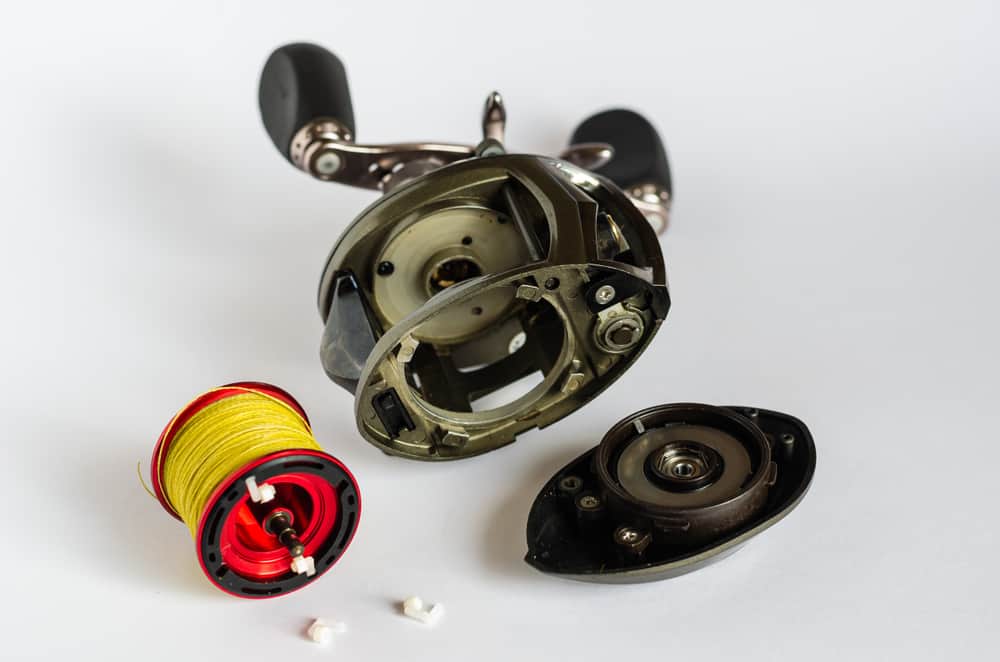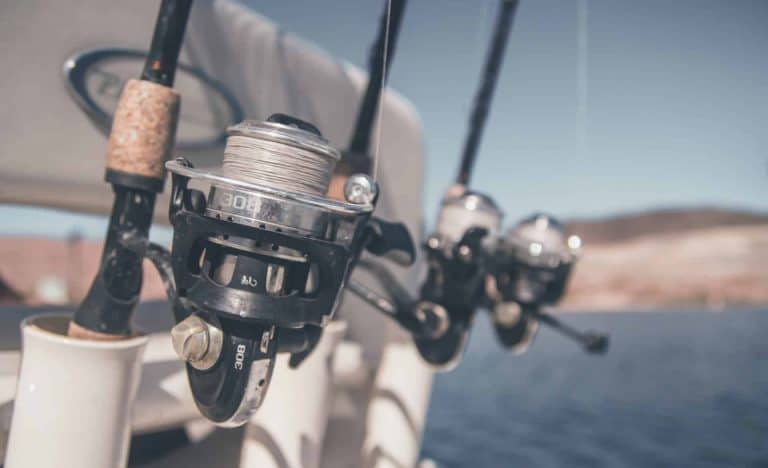Magnetic Vs Centrifugal Brake Baitcaster
There are two main brakes used on a baitcasting reel, and these are magnetic and Centrifugal.
Some people prefer to use the old fashioned method of slowing their line, and that process simply involves just your thumb, but most of us can’t create the control we need without a little help from some mechanics.
But which brake should you go for? The magnetic brake baitcaster or the centrifugal brake baitcaster?
Well they are both great choices depending on how you like to fish, so let’s dive into what makes them different.

Table of Contents
Centrifugal Brake Baitcaster
Centrifugal brakes are also known as the “one and done” brake. This is because you can set up your centrifugal brake once, and never have to touch it again.
How Do Centrifugal Brakes Work?
Centrifugal brakes only work on the first movement on your cast. When you fling your line towards the target, the spool will begin to turn at a high speed. If your spool is spinning faster than your lure is traveling, then you will end up with a ton of loose fishing line ready to get tangled in the water.
The centrifugal brake controls how much line is allowed to feed off from the spool, so that it matches the speed of your cast. As the spool spins, the centrifugal force will activate.
Centrifugal force is when an apparent force is felt by an object which is moving around a curved path. Imagine you are driving a vehicle around a traffic circle, the faster you go the stronger you will feel this force pulling you.
The spool will run along a shelf inside the brakes side panel, as the centrifugal force pulls it across the brake pads.
What Are The Main Features Of Centrifugal Brakes?
To make these brakes work, you need to already have the settings prepared. This brings us back to the “one and done” idea. To make the brakes adjusted to your taste, you need to remove the side plane, and move the pegs into the “on” or “off” position.
If the pegs are “on”, they will be actively slowing your spool down. You need to make sure that the “on” and “off” ratio is evenly balanced; otherwise, you will lose control of the spool.
All of these fiddly components mean that the centrifugal brakes are a pain to get right. However, once you have tested the line’s speed and are happy with the level of brakes, you can put the side panel back on and not have to worry about the brakes again.
Magnetic Brake Baitcaster
Magnetic brakes are the easiest brakes to use, but you also have less control over the speed.
How Do Magnetic Brakes Work?
Magnetic brakes use a magnetic force to control the speed of your spool. The number of magnetics doesn’t change, unlike the centrifugal brakes. Instead, the change in speed comes from the proximity of the spool to the magnetic.
The closer the magnetics are, the stronger the magnetic force is, and therefore the harder it is for the spool to gain speed.
Again these brakes only work on the first part of your casting, and so you will not be able to slow the spool down once it has already left the mechanism.
What Are The Main Features Of Magnetic Brakes?
Magnetic brakes are easier to adjust than centrifugal brakes, as you don’t need to unscrew the panel to make the changes. Instead, all you need to do is move the dial.
The dial will either move from 0 to 10 or will simply show you a rotation of minimum brake to maximum brake. Either way, to adjust the level of friction on the spool, all you need to do is move the dial to the appropriate level.
This means adjusting for wind changes, distance, and fish type is as easy as moving the knob. You can even move the dial to precise locations such as 6.5 or 5.25, to give yourself complete control over the magnetic force.
The downside to this much flexibility is that you won’t be able to practice throwing your line on the same brake level every time. This is because the dials are so easy to move that a simple knock will change the adjustment.
For example, you can attempt to keep the dial at 5, but in reality, it might be 5.1 for an hour, and then 5, and then 4.9, and so on.
Which Baitcaster Brake is Better? Magnetic or Centrifugal Brake Baitcaster?
The answer to this question depends on how you like to fish. Do you want to calibrate the perfect brake for your fishing type and then never think about it again, or do you want to change up your braking speed to match the activity on the day?
If you want to keep your brakes at a constant restriction level and don’t feel the need to mess around with its mechanics, then choose the centrifugal brake baitcaster.
If you like to change up your braking speed depending on the weather, the location, and how well you are doing on the day, pick the magnetic braking system.
What Does The Braking System On A Baitcaster Do?
After all this talk on braking systems, you might be wondering why your rod would even need these mechanics in place.
The answer is in your spool and its tangles. Every baitcaster will already have a braking system installed on it. The brakes slow down your spool while it is being released, this is so only the right amount of lure hits the water.
When your lure hits the water, it will start to slow down. Without a break in place to match these reduced movements, the spool will continue to release its line, resulting in a tangled mess in the water.
The brakes slow this process down, so the amount of line hitting the water is reduced, causing you to have a healthy spool with suitable tension.



![Best Fishing Line For Crappie – Our 6 Top Picks [Buyers Guide]](https://watersportingadventure.com/wp-content/uploads/2020/10/Crappie_Fishing_6279997935-scaled-e1602175209151-768x347.jpg)


